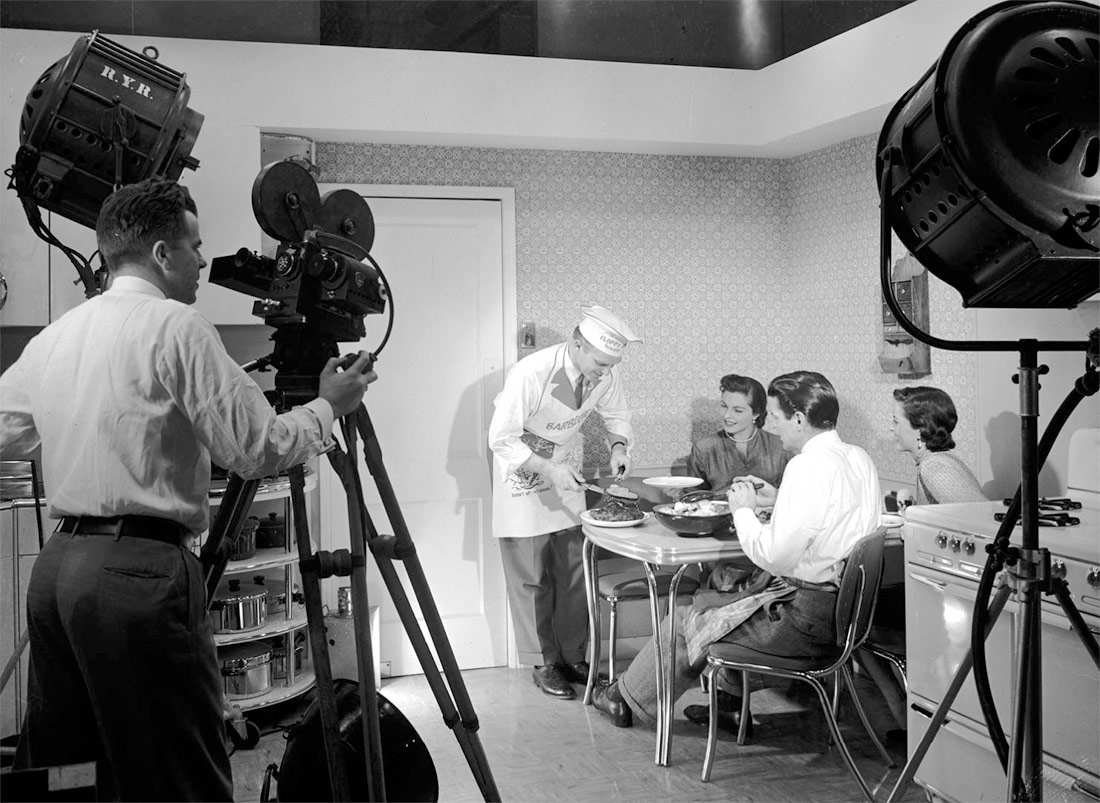
Filming Actors at Table, Motion Picture Kitchen Set. Texas, ca. 1951 | Robert Yarnall Richie, DeGolyer Library, Southern Methodist University | No known copyright restrictions
The boundaries between on and offline life have long since become blurred. However, it now seems that the true kernel of our lives lies inside the web. We no longer just show who we are, but we live our lives as a fiction designed to be spread on social media.
As I look through the photo gallery on my phone, it suddenly comes to me. It’s been days since I posted anything. Instinctively, I go through each image in the gallery to weigh up its potential. Do I exist, if nobody sees me? Or even worse, do I have any control over who I am in this world, unless I share every detail with all and sundry? Like a Greek hero up against the fate imposed by the gods, I embark on my quest. It doesn’t matter if it’s a nice picture, or if I look good in it. In fact, I don’t even have to be in it, and it’s even better if I’m not. I only consider what it will say about me and whether it will be able to explain the future I want, to others and to myself. Scrolling through my photos, I imagine what you’ll think of the books I read, or of the startling depth of the phrase that I’ve wisely highlighted; of the bars I know, and my half-eaten meals there. In a recent article, Rebecca Jennings wrote that, whether we are office workers, astronauts or writers, we can no longer escape the tyranny of the personal brand. I would go even further, and say that while in the past few years we subjugated our online presence to faithfully show who we were offline, we now do the opposite – we try to be faithful in life to the persona we have created online. Does it make sense to keep talking about truth and lies on the internet?
A few months back, before posting a photo, Instagram started giving the option of seeing how it would look on your profile grid. It’s an extremely useful tool for corporate accounts, but when I do it myself, I become doubtful. I hesitate. The sentence I’ve chosen doesn’t quite fit in with the other posts. If I choose a photo of myself, it’s too close to the last one where you can see my face, so I have to look for a third option. If you add this to the fact that the algorithm prioritises companies and professionals, so that you have to go and search for the profiles of the humans you’re interested in to see the posts, it becomes even more evident that the image you put on the internet no longer makes sense in itself, but takes on meaning when it becomes another piece of your mosaic. To give an example, “photo dumping,” or the trend of posting collections of images in a single post, represents yet a further level of abstraction of the self through images. The countryside, the dirty dishes from the barbecue, the blurry photo of your friends at a party… none of them would make sense without the others, and they can only be understood in terms of what they tell us about you. The image is no longer an object to be consumed – on the internet, you are.
In 2006, Lonelygirl15 posted her first YouTube video. It’s a minute-and-a-half-long vlog that appears to have been recorded with a computer webcam. Bree, a teenager who barely looks at the camera, talks to her viewers in a shy voice. Although the term “viewers” is anachronistic. In 2006 there were no social networks as we know them today – no influencers, or even followers, just communities. Lonelygirl15, Bree, hugs her knees and lists her favourite users of the platform, explaining that “because she really likes a lot of the guys on here, she’s decided to post a video herself.” Her subsequent posts begin to feature all the users she mentions by their YouTube names. Soon, a four- or five-way network of crossed videos and content is generated so that the viewer can follow the teenager’s adventures, as she talks about fights with her parents or outings with friends. Eventually, however, it came out that the teenager in the videos was really an adult actress performing a script created by a whole production team, and that those Lonelygirl15 vlogs were nothing more or less than the first web series in the history of YouTube.
ARVE Error: src mismatch
url: https://www.youtube.com/watch?v=-goXKtd6cPo&ab_channel=lonelygirl15
src in: https://www.youtube-nocookie.com/embed/-goXKtd6cPo?feature=oembed&enablejsapi=1&origin=https://lab.cccb.org
src gen: https://www.youtube-nocookie.com/embed/-goXKtd6cPoActual comparison
url: https://www.youtube.com/watch?v=-goXKtd6cPo&ab_channel=lonelygirl15
src in: https://www.youtube-nocookie.com/embed/-goXKtd6cPo?enablejsapi=1&origin=https%3A%2F%2Flab.cccb.org
src gen: https://www.youtube-nocookie.com/embed/-goXKtd6cPo
I like to think that, in one way or another, on the internet we’re all making our own web series. This fictitious self, taken to the extreme, is what explains the birth of the influencer. These internet users who speak to us through the screen must manage to be both relatable and aspirational, friendly and commercial. To provide reassurance that they’re just like us, but also everything we wish to be. Their power comes from transforming lies into promises. Influencers exist because they make us want to live like them, but also because, in order to live like they do but outside the internet, we have to imitate their online life – the same photos, angles, trips, purchases and compositions. We buy each other’s lies in the hope that they will become true off-screen.
But what I find most curious about the Lonelygirl15 case is not the fiction, but its clairvoyance. This collaborative and experiential content used the same key elements that, 10 years later, would ensure the massive success of groups like the Vlog Squad, which dominated the YouTube scene between 2015 and 2021. They did so, moreover, without being part of any specific community or interest group, but by focusing instead on “lifestyle” content – outings, habits, errands, coffees, lunches, dinners, trips, get-togethers and lots and lots of shopping, all accompanied by a friendly voice. The formula for the success of these groups lies precisely in the fact that they create multi-perspective content, so that, while you establish a relationship with one creator, you can see the same thing from one, two or three different perspectives through the other members of the group. A parasocial relationship in three dimensions.
In the case of the Vlog Squad, led by the youtuber David Dobrik, the format was stretched like chewing gum with the force of the click and the ease of the hyper-consumerism that was already beginning to nibble away at YouTube. Soon, all the channels were infected by the same evil – “Surprising friends with three new Mercedes,” “I buy a giant slide to see what happens,” “Trying the entire Burger King menu.” Neither their life nor their relationship with each other was enough to keep up with the pace, so in addition to videoing their day-to-day life, they had to start living through the algorithm. They made the lie come true and stopped being the aspirational example that followers wanted to emulate, to become slaves to the YouTube homepage. In 2022 Dobrik was sued for more than $10 million for crushing one of his fellow Vlog Squaders with an excavator. The accident took place while filming a video where Dobrik surprised his friends with the machine, which he used to throw them in spectacular style into a Utah lake.
After the pandemic, and with the growth of the alt-right (especially on the internet), the shadow land between lies and truth has become open to conquest and fertile for propaganda. Personally, the phenomenon that most intrigues me in this quagmire is the appearance of “tradwives.” In recent months, Nara Smith’s account has drawn a large amount of attention. She’s a young housewife who makes cooking videos, and on her TikTok we see her sporting a silk dressing gown and a French bob as she sinks her perfectly manicured hands into a mass of eggs and flour. I spy her making homemade Oreo cookies and can’t help wondering about the dough that must get stuck under her long, shiny nails, which are different with every recipe. But I know that the point of the video isn’t to show me how to make cookies, but rather the gorgeous manicure she can afford precisely because she’s the kind of woman who stays at home baking cookies. The image, these recipes, are the excuse to explain who she is – a woman, a mother, traditional and conservative, living in a luxurious idyll of marble and air fryers, courtesy of her Mormon husband.
Aestheticisation, in this case of conservatism, means that the truth is watered down by the desire to live like we do on social media. We all know that, historically, the traditional role of spouse and housewife has more to do with domestic slavery than with expensive manicures, but the possibility of being able to repeat the lie on TikTok is enough to make us believe. I don’t think it’s about demanding that people be honest on the internet, especially at this late date. But it might be useful to go back to the beginnings, to 2006, and see the internet as a tool of fiction. And the content, as our own web series.





Leave a comment